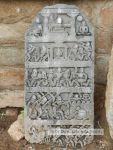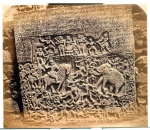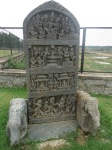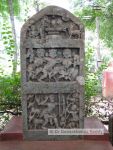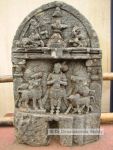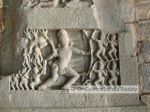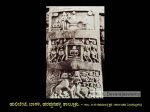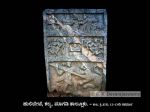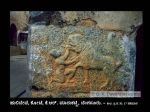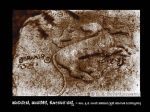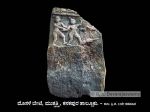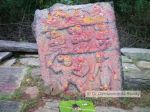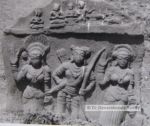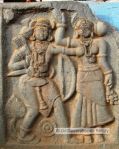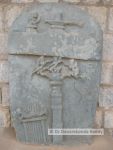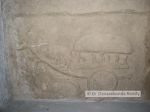MEMORIAL STONES
Best of inscriptions found in Karnataka are Memorial Stones. They are very unique to Karnataka and the varieties in them are stupendous. And are found nowhere else in whole of India. Some of them are also found outside the state, in territories which were part of dynasties of Karnataka.
Memorial Stones are those stones dedicated to a person who sacrificed his life for the cause of king or public in war, battlefield; cattle raids and safeguard life and dignity of women from miscreants. Such men, who selflessly pledged their life for the protection of his village men and property, were raised to the status of demigod and became the hero of the village. In their commemoration the village men or his relatives erected a stone in front of the temple or in village forum.
A Hero stone is divided into three sections, the lower portion gives details of the hero and his act of sacrifice. The sculpture will have, hero fighting the enemy with a sword or a bow, the army, cattle, women in distress. This section generally depicts the reason for his /her death. The middle portion depicts the hero who sacrificed his life being carried away to heaven (swarga) by angels. The third portion depicts him sitting in front of a God.
These memorial stones are classified accordingly to the content of their text and sculpture found on them. They are found with or without inscriptions.
| Veeragallu–Hero Stone | Masti Kallu | Keelgunte | Sidi Thale | Dharmika Riligious | Unclassified |
Dr. Devarakonda Reddy has beautifully explained in detail about each of these categories in this document:
Explanation of different varieties of Memorial Stones (in Kannada).
You can find detailed description of two of the most unique memorial stones found in Karnataka, that of Dekabbe and Begur Veeragallu in this document:
Memorial Stones – Dekabbe and Begur Veeragallu Explained (in Kannada).
There are no memorial stones in whole of India that can be compared to these two with respect to wonderful depiction of events with detailed description inscribed on them.
ವೀರಗಲ್ಲು Veeragallu – Hero Stone
Hero stones are memorial stones erected in memory of heroes who died in a battle field while defending kings, or defending the cattle or women in distress.
Hero stone are found all over Karnataka, about half of the hero stones found have no inscriptions on them, the concentration of hero stones can be found in these districts : Kolar, Shimoga, Tumkur, Bangalore and Haveri .
Hero stone is a unique feature of Karnataka inscriptions, other than Karnataka we can find hero stones in Tamil Nadu, Andhra Pradesh and Maharashtra, because of the proximity , we can find Hero stones even these regions. War memorial Hero stones are found all over Karnataka.
Hero Stones can be further divided into these criteria:
ಯುದ್ಧ, ಕೋಟೆಕಾಳಗ – Hero stones on Attack of Forts
There are many beautiful hero stones in Karnataka which depict war scenes with soldiers riding on horses and elephants. Some of them also have a fort wall etched in them. The most notable and one of a kind in whole of India is the Begur Veeragallu which is now housed in Bangalore Museum. In pitched battles, expert skilled soldiers used to stage ahead to capture the fort gate. For soldiers who got killed during the attach of the fort, their master / King honored them by erecting memorial stones. These stones are usually ornately sculpted, and depict the soldier in the battle field and might not contain inscriptions. To sight one such Hero stone, the one in Lakshmeshwar, Gadag district, depicts a soldier who was killed while removing the stones of the forts, there by causing great damage to the security of the fort. Hero Stones at Abblur, Mavali, Hamsabhavi, depict the attack on forts.
ಊರಳಿವು – Ooralivu – Defending Village
These hero stones were erected for the persons who died while fighting to save their village against enemy attack to capture the village. Inscriptions on some of the stones describe the scene as to, how adventurous youngsters mobilized with arms, faced such attacks and died safeguarding the village.
ಗಡಿಕಾಳಗ – Gadi Kalaga – Defending Border
These hero stones were laid for persons who died while defending their village territory. Minor wars used to take place between the neighboring villages, when one village tried encroaching upon the land belonging to the neighboring village. Such border disputes was very common in olden days.
- Begur Hero Stone Inscription: The best hero stone available in whole of India, now preserved in Bangalore Museum
ಗೋಗ್ರಹಣ, ತುರುಗೋಳ್ – Go Grahana, Turugol – Defending Cattle
These hero stones were erected for people who died while defending cattle theft or siege of cattle by neighboring villages. In ancient and medieval period, cattle was considered as wealth. The capture of cattle in the enemy territory was considered as an act of pride. We find such references to it even in Mahabharatha; the Virataparva ends with gograhana i.e capture of cows at Viratanagari. Such attack was considered as a matter of insult to a village and they usually staged an attack to recapture the lost cattle. Hero stones were laid for village fellow men who tried to bring back their lost cattle, those people were remembered as heroes of the village.
ಪೆಂಡಿರುದಡೆಯುರ್ಚು, ಪೆಣ್ಬುಯ್ಯಲ್ – Pendirudeyurchu, Penbuyyall
ಬೇಟೆ – Bete – Hunting Wild Animals
Death while killing a wild beast. Since there are various varieties in this category, they have been classified based on the type of the wild beast which caused the death.
Hunting was a very popular recreational game in Karnataka and in Indian at large. We have epigraphs and also literary works describing in detail the hunting expeditions in ancient days. Hunting is one of the chapters in 18 varnanas (Ashtadasa). According to epigraphical evidences, boar hunting was very popular. Epigraphical sculptures narrate different types of Boar hunting using trained dogs. Sculptures on the epigraphs depicts, hunting with one or two dogs attacking or cornering the boar. These sources tell us the importance of dogs in hunting. Atakur inscription (dated 949.A.D) is an inscribed memorial stone erected by a grief-stricken owner in honor of his brave dog, which died while killing a wild boar; this stone erected in memory of an animal is considered a unique one. Melagani located in Mulbagal taluk, Kolar, has two memorial stones of 10th century erected for heroic endeavor of two hounds namely Loga and Dhalaga. Loga had attacked and killed 70 boars in its life time and Dhalaga also had attacked and killed 50 boars in its life time.
ಹಂದಿಬೇಟೆ – Handi Bete
Death while killing a Wild Boar.
ಹುಲಿ ಬೇಟೆ – Huli Bete
Death while killing a Tiger.
Other Wild Animals
Death while killing dear, crocodile or while defending oneself from a bear attack.
Capture of Wild Elephant – ಖೆಡ್ಡ – Kedda
This memorial stone is very rarely found.
ಮಾಸ್ತಿ – Masti – Maha Sati – Mastikallu – Self Sacrifice on Pyre
Memorial stones erected in memory of a lady who invited the death by self immolation after hearing the death of her husband. These stones can be seen as Masti and Veera Masti. Usually Masti stones show a right hand rising towards heaven which symbolizes blessings to all human beings is called ‘Vyasana Tholu’. The lady who invited death this way was given divine status and was worshiped as a Goddess. Masti stones are unique to Karnataka. With detailed studies of these stones and other literary sources, historians note that ‘Sati’ ritual in Karnataka was never forced upon women, rather it was done voluntarily.
Masti
Masti stones are classified based on, whether the woman sacrificed her life along with the dead body of her husband or without.
ಸಹಗಮನ – Sahagamana
The lady entered the pyre along with body of her Husband.
ಅನುಗಮನ – Anugamana
The lady entered the pyre upon hearing the death of her husband in the absence of her husband’s body. The most notable and beautiful one found is the Dekabbe shasana(EC (R) Vol 3, 60, Belathur) belonging to 1057 AD with inscriptions which is five layered and explains the story and the events of Dekabbe’s Anugamana ritual.
- Dekabbe Memorial Stone
ವೀರಮಾಸ್ತಿ – VeeraMasti kallu
Memorial stones with both the hero and his wife/wives. They are erected in memory of a hero who died a heroic death and his wife/wives who invited the death by self immolation after hearing the death of her husband.
ಕೀಲ್ಗುಂಟೆ – Keelgunte – Self Burial
Kilgunte denotes live burial, plunging into pyre, falling from height and allowing oneself to be slammed, a person sacrifices his life with demise of his master or king. We have inscriptions along with text giving details of Kilgunte practice, but associated sculpture is rarely found. Doddahundi memorial stone (840 or 869 A.D ) has a unique depiction in frieze of the ritual death of the Western Ganga king Ereganga Nitimarga I. The memorial stone has its frieze set inside a square panel whose borders are etched to create the impression of flames that further accentuate the grave event. The dying king, who exudes a calm countenance, is lying on a couch with his head on a double pillow and is attended to by his personal guard Agarayya. An agitated Prince Satyavakya stands behind the king with a dagger and sword. The inscription below the frieze reads “bee at the pair of lotus feet of Arhat Bhattaraka”. This is typical example of Kilgunte memorial stone of type velevali ವೇಳೆವಾಳಿ . Some individuals will have taken an oath to sacrifice their lives in order to save their master’s life as bodyguards and when the occasion demands such as death of their masters due to war, illness, etc,. they follow their master in death. These individuals and the practice were called ‘garuda’s (lenka) ಗರುಡ (ಲೆಂಕ) and ‘velevali’ ವೇಳೆವಾಳಿ respectively. Doddahundi and Hemavati are fine examples of Kilgunte inscription.
ಸಿಡಿ ತಲೆ – Sidithale
Sidi – ‘blast’, thale – ‘head’. These are memorial stones which depict self scarifies by be-heading and cutting of throat. The person is hanged to a bamboo pole which is bent. His throat is cut by knife and his head would blast off from the body as the pole gets straightened. This would tear apart his head from the body, and the head is swung away. These have been classified based on the whether the person sacrificed his life for his family’s welfare or for the welfare of the king.
ತನಗಾಗಿ ಆತ್ಮಬಲಿ – Athmahuthi – Self Sacrifice
Memorials of the persons who invite death by cutting their throat for the welfare of his family.
ರಾಜನಿಗಾಗಿ ಆತ್ಮಬಲಿ – Sacrifice for the welfare of the king
Memorials of the royal servants who invite death by cutting their throat for the welfare of his family of their masters.
ಧಾರ್ಮಿಕ – Dharmika – Religious
There are memorials stones found in Karnataka of the persons who invited death in a religious way to attain Moksha – freedom from the cycle of birth and death. They have been classified as follows.
ನಿಸಿದಿ – Nisidi
There are memorials stone of the religious persons of Jaina sect to who invited the death in a religious way called Sallekana.
Dharmika Karya – Religious Ritual
Inviting death on an auspicious day in a holy place. Hindus believe that a person attains Moksha, if death occurs in a holy place or on a auspicious day.
ಉರಿ ಉಯ್ಯಾಲೆ – Uri Uyyale – Swing on a fire
This is a ritual where in, on the day of solar eclipse, one sacrifices his life swinging over a religious fire.
ಗೂಟಗಳ ಮೇಲೆ ಬೀಳುವುದು – Falling on a sharp piercing arrow
This is a ritual where in, on a precious day, one sacrifices his life falling on a sharp iron rod/arrow.
ಶೂಲ – Shoola – Sitting on sharp objects
This is a ritual where in, on a precious day, one sacrifices his life sitting on a sharp object which pierces his body.
ಆಯಕಾ – Aayaka
There are memorials stone of the religious persons of Boudhha (Buddhism) sect, usually depicted as part of ‘Jataka’ tales. Such memorial stones belonging to Ashoka period are found in northern Karnataka.
Unclassified
There are many memorial stones which are yet to studied and understood like the ones shown below.







